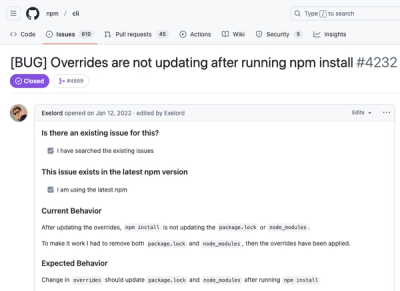react-style-tag
Write styles declaratively in React
Table of contents
Installation
$ npm i react-style-tag --save
Usage
import { Style } from 'react-style-tag';
const Style = require('react-style-tag').Style;
Implementation
import React, { Component } from 'react';
import { Style } from 'react-style-tag';
function App() {
return (
<div>
<h1 className="foo">Bar</h1>
<Style>{`
.foo {
color: red;
&:hover {
background-color: gray;
}
@media print {
color: black;
}
}
`}</Style>
</div>
);
}
Summary
react-style-tag creates a React component that will inject a <style> tag into the document's head with the styles that you pass as the text content of the tag. Notice above that the styles are wrapped in {`and`}, which create a template literal string. Internally, react-style-tag parses this text and applies all necessary prefixes via stylis. All valid CSS is able to be used (@media, @font-face, you name it), and you can use nesting via the use of the & reference to the parent selector.
The style tag that is injected into the head will be automatically mounted whenever the component it is rendered in is mounted, and will be automatically unmounted whenever the component it is rendered in is unmounted.
Scoped Styles
There is an additional utility provided that can help to scope your styles in the vein of CSS Modules, and this is hashKeys. This function accepts an array of keys to hash, and returns a map of the keys to their hashed values.
import { hashKeys, Style } from 'react-style-tag';
const { foo, bar } = hashKeys(['foo', 'bar']);
function App() {
return (
<div>
<div className={foo}>My text is red due to the scoped style of foo.</div>
<div className={bar}>
My text is green due to the scoped style of bar.
</div>
<div className="baz">My text is blue due to the global style of baz.</div>
<Style>{`
.${foo} {
color: red;
}
.${bar} {
color: green;
}
.baz {
color: blue;
}
`}</Style>
</div>
);
}
Notice you can easily mix both scoped and global styles, and for mental mapping the scoped styles all follow the format scoped__{key}__{hash}, for example scoped__test__3769397038. The hashes are uniquely based on each execution of hashKeys, so the implementation can either be Component-specific (if defined outside the class) or instance-specific (if defined inside the class, on componentDidMount for example).
Props
Naturally you can pass all standard attributes (id, name, etc.) and they will be passed to the <style> tag, but there are a few additional props that are specific to the component.
hasSourceMap
boolean, defaults to false in production, true otherwise
If set to true, it will render a <link> tag instead of a <style> tag, which allows source referencing in browser DevTools. This is similar to the way that webpack handles styles via its style-loader.
The use of sourcemaps require the use of Blob, which is supported in IE10+, Safari 6.1+, and all other modern browsers (Chrome, Firefox, etc.). If you browser does not support Blob and you want to use sourcemaps, you should include a polyfill. Recommended is blob-polyfill.
Make sure this import occurs prior to the import of react-style-tag to ensure blob support is present.
isMinified
boolean, defaults to true in production, false otherwise
If set to false, it will pretty-print the rendered CSS text. This can be helpful in development for readability of styles.
isPrefixed
boolean, defaults to true
If set to false, it will prevent stylis from applying vendor prefixes to the CSS.
Global Options
All of the props available are also available as global options for all instances that can be set with the setGlobalOptions method:
import { setGlobalOptions } from 'react-style-tag';
setGlobalOptions({
hasSourceMap: true,
isMinified: true,
isPrefixed: false,
});
Development
Standard stuff, clone the repo and npm i to get the dependencies. npm scripts available:
build => run rollup to build dist filesdev => run webpack dev server to run example app / playgrounddist => runs build and build:minifiedlint => run ESLint against all files in the src folderlint:fix => runs lint with --fixprepublishOnly => run lint, typecheck, clean, test, transpile:es, transpile:lib, and disttest => run jest test functions with NODE_ENV=testtest:coverage => run test, but with coverage checkertest:watch => run test, but with persistent watchertranspile:lib => run babel against all files in src to create files in libtranspile:es => run babel against all files in src to create files in es, preserving ES2015 modules (for
pkg.module)typecheck => check for TypeScript errors



